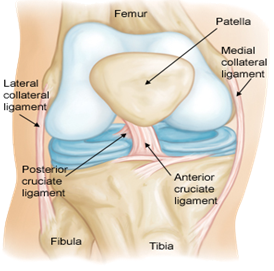Knee Injury Information and Advice
This leaflet gives you advice and exercises to help your knee to recover after your injury.

Knee Injury
Knees can be injured in many different ways and can involve a number of different structures to include:
- Bone
- Ligaments
- Cartilage (meniscus)
- Tendons
- Muscles
Following a knee injury, you are likely to experience some or all of the following: pain, swelling, stiffness and / or loss of movement, weakness of the thigh muscles and tightness at the back of the knee.
In young patients swelling is an abnormal finding and does warrant further review by a specialist.
Management
Unless otherwise advised, it is important to try and move your knee as normal. At first it may feel stiff and painful. Maintaining your range of movement, especially extension (straightening) is particularly important.
You may be given a brace, depending on the extent of your injury. You will be given instructions on how to use this.
Walking
Depending on the extent of your injury, you may be given elbow crutches to enable you to walk with a good gait (walking) pattern. Always try to walk normally, by putting your heel down first.
It is important to remain mobile if possible; however, in the early stages after your injury, doing too much will cause increased pain and swelling. You need to monitor the pain and swelling and adjust the amount of activity accordingly.
Gradually wean off Elbow Crutches (if applicable) and increase your activity as pain and swelling subside. Before considering a return to any sporting activities you need to complete a basic exercise programme with focus on your strength and single leg control. Do NOT return to sport until you are fully fit or when advised by a doctor or physiotherapist.
Swelling and pain
If you have swelling associated with your injury it is important to try eliminate this as soon as possible. This can be achieved by doing RICE (Rest / Ice / Compression / Elevation):
- Rest: Monitor your activity. Ensure you are not doing “too much” causing further swelling.
- Ice: Apply ice, wrapped in a damp tea towel, for up to 15 minutes on your, 3-4 times per day.
- Compression: Apply tubigrip (elastic bandage) can help to control swelling and make your knee feel more supported.
- Elevate: When resting keep your injury limb elevated on a footstool or pillows. Ideally your knee should be higher than your hip.
Basic exercises
It is important to start some basic exercise as soon as possible to try and regain your movement and keep muscle activation and strength.
The exercises are most effective if practiced regularly. We suggest 3-4 times per day.


